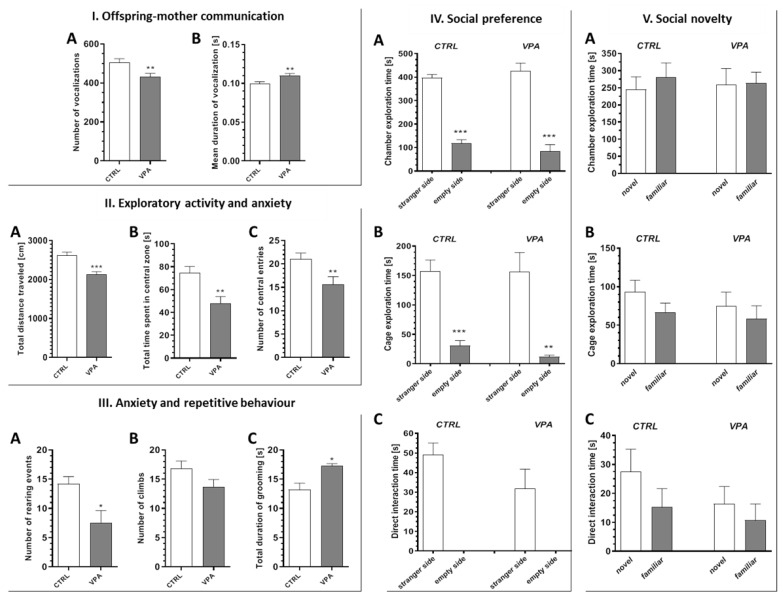Figure 1.
The effect of prenatal exposure to valproic acid (VPA) on offspring behaviour. (I). The impact of prenatal exposition to VPA on offspring–mother communication. The behaviour of control rats and rats exposed to VPA was analysed at postnatal day 11 in the juvenile isolation test. (A) The total number of ultrasonic vocalization events during the trial, n = 90 (CTRL), n = 88 (VPA); (B) the duration of average ultrasonic vocalization event, n = 90 (CTRL), n = 91 (VPA). (II). The impact of prenatal exposition to VPA on exploratory activity and anxiety. The behaviour of control rats and rats exposed to VPA was analysed at postnatal day 55 in the open-field test. (A) The total distance travelled by animals, n = 58 (CTRL), n = 48 (VPA); (B) the time spent in the central zone, n = 50 (CTRL), n = 39 (VPA); (C) the number of entries to the central zone, n = 45 (CTRL), n = 33 (VPA). (III). The impact of prenatal exposition to VPA on anxiety and repetitive behaviour. The behaviour of control rats and rats exposed to VPA was analysed at postnatal day 55 in the open-field test. (A) The number of rearing events, n = 10 (CTRL), n = 7 (VPA); (B) the number of climbing events, n = 10 (CTRL), n = 7 (VPA); (C) the total time spent on self-grooming, n = 9 (CTRL), n = 5 (VPA). Data represent the mean values ± SEM. (IV,V). The impact of prenatal exposition to VPA on social behaviour. The behaviour of control rats and rats exposed to VPA was analysed at postnatal day 57 in a three-chamber sociability and social novelty test (Crawley’s test). (IV). (A) The time spent on the exploration of each chamber during the social preference test, (B) the time spent on exploration of each cage during social preference test, and (C) the time spent on direct interaction with the other animal during social preference test. (V). (A) the time spent on the exploration of each chamber during a social novelty test, (B) the time spent on exploration of each cage during a social novelty test, and (C) the time spent on direct interaction with the other animal during a social novelty test. Data represent the mean values ± SEM from n = (5–8). * p < 0.05, ** p < 0.01, *** p < 0.001.

